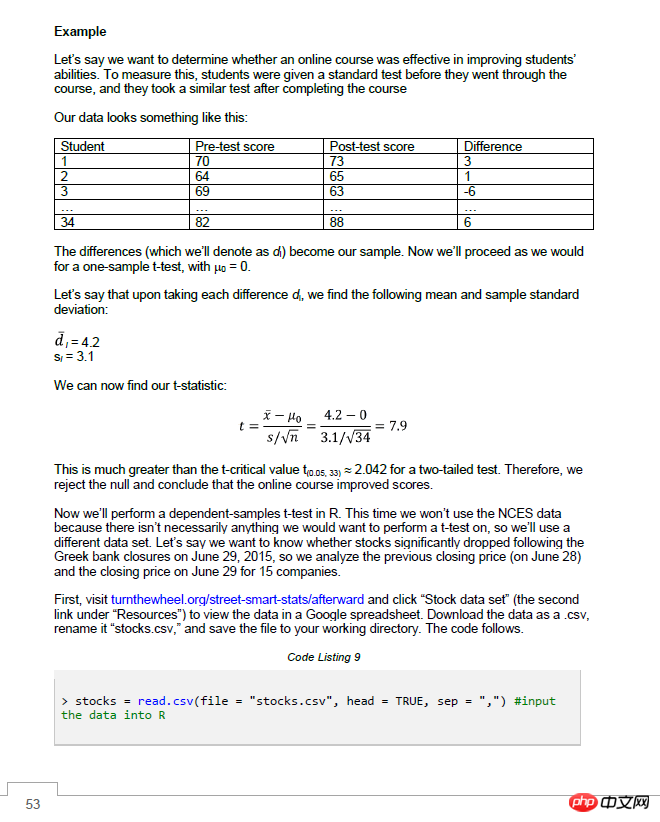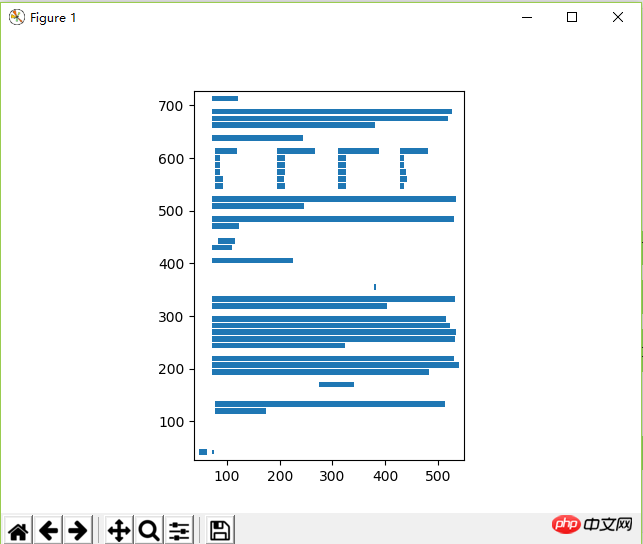 Backend Development
Backend Development
 Python Tutorial
Python Tutorial
 How to crawl tabular data from PDF files in Python (code example)
How to crawl tabular data from PDF files in Python (code example)
How to crawl tabular data from PDF files in Python (code example)
The content of this article is about how Python can crawl tabular data from PDF files (code examples). It has certain reference value. Friends in need can refer to it. I hope it will be helpful to you. .
This article will show a slightly different crawler.
In the past, our crawlers crawled data from the Internet, because web pages are generally written in HTML, CSS, and JavaScript codes. Therefore, there are a large number of mature technologies to crawl various data in web pages. This time, the documents we need to crawl are PDF files. This article will show how to use Python's camelot module to crawl tabular data from PDF files.
In our daily life and work, PDF files are undoubtedly one of the most commonly used file formats. We can all see this file format, ranging from textbooks and courseware to contracts and planning documents. But how to extract tables from PDF files is a big problem. Because there is no internal representation in PDF to represent a table. This makes tabular data difficult to extract for analysis. So, how do we crawl table data from PDF?
The answer is Python’s camelot module!
camelot is a module for Python that allows anyone to easily extract tabular data from PDF files. You can use the following command to install the camelot module (it takes a long time to install):
pip install camelot-py
The official documentation address of the camelot module is: https://camelot-py.readthedoc....
The following will show how to use the camelot module to crawl tabular data from PDF files.
Example 1
First, let us look at a simple example: eg.pdf. The entire file has only one page, and there is only one table in this page, as follows:

Use the following Python code to extract the table in the PDF file:
import camelot
# 从PDF文件中提取表格
tables = camelot.read_pdf('E://eg.pdf', pages='1', flavor='stream')
# 表格信息
print(tables)
print(tables[0])
# 表格数据
print(tables[0].data)The output result is:
<tablelist>
<table>
[['ID', '姓名', '城市', '性别'], ['1', 'Alex', 'Shanghai', 'M'], ['2', 'Bob', 'Beijing', 'F'], ['3', 'Cook', 'New York', 'M']]<p>Analysis code, camelot.read_pdf() is camelot's function to extract data from a table. The input parameters are the path of the PDF file, the page number (pages) and the table parsing method (there are two methods, stream and lattice). For the table parsing method, the default method is lattice, and the stream method will parse the entire PDF page as a table by default. If you need to specify the area in the parsed page, you can use the table_area parameter. <br> The convenience of the camelot module is that it provides functions to directly convert extracted table data into pandas, csv, JSON, and html, such as tables[0].df, tables[0].to_csv() function wait. Let’s take the output csv file as an example: </p>
<pre class="brush:php;toolbar:false">import camelot
# 从PDF文件中提取表格
tables = camelot.read_pdf('E://eg.pdf', pages='1', flavor='stream')
# 将表格数据转化为csv文件
tables[0].to_csv('E://eg.csv')The obtained csv file is as follows:

Example 2
In Example 2, we will extract table data in a certain area of the PDF page. The pages (parts) of the PDF file are as follows:

In order to extract the only table in the entire page, we need to locate the location of the table. The coordinate system of the PDF file is different from that of the picture. It takes the vertex of the lower left corner as the origin, the x-axis to the right, and the y-axis upward. The coordinates of the text on the entire page can be output through the following Python code:
import camelot
# 从PDF中提取表格
tables = camelot.read_pdf('G://Statistics-Fundamentals-Succinctly.pdf', pages='53', \
flavor='stream')
# 绘制PDF文档的坐标,定位表格所在的位置
tables[0].plot('text')The output result is:
UserWarning: No tables found on page-53 [stream.py:292]
The entire code does not find the table. This is because the stream method treats the entire PDF page as a table by default, so the table is not found. But the image of the drawn page coordinates is as follows:

Carefully comparing the previous PDF pages, we can easily find that the coordinates of the upper left corner of the area corresponding to the table is (50,620), and the coordinates of the lower right corner are (500,540). We add the table_area parameter to the read_pdf() function. The complete Python code is as follows:
import camelot
# 识别指定区域中的表格数据
tables = camelot.read_pdf('G://Statistics-Fundamentals-Succinctly.pdf', pages='53', \
flavor='stream', table_area=['50,620,500,540'])
# 绘制PDF文档的坐标,定位表格所在的位置
table_df = tables[0].df
print(type(table_df))
print(table_df.head(n=6))The output result is:
<class> 0 1 2 3 0 Student Pre-test score Post-test score Difference 1 1 70 73 3 2 2 64 65 1 3 3 69 63 -6 4 … … … … 5 34 82 88 6</class>
Summary
In specific identification of PDF pages When creating a table, in addition to the parameter of specifying the area, there are also parameters such as superscript and subscript, cell merging, etc. For detailed usage, please refer to the camelot official document website: https://camelot-py.readthedoc....
The above is the detailed content of How to crawl tabular data from PDF files in Python (code example). For more information, please follow other related articles on the PHP Chinese website!

Hot AI Tools

Undresser.AI Undress
AI-powered app for creating realistic nude photos

AI Clothes Remover
Online AI tool for removing clothes from photos.

Undress AI Tool
Undress images for free

Clothoff.io
AI clothes remover

AI Hentai Generator
Generate AI Hentai for free.

Hot Article

Hot Tools

Notepad++7.3.1
Easy-to-use and free code editor

SublimeText3 Chinese version
Chinese version, very easy to use

Zend Studio 13.0.1
Powerful PHP integrated development environment

Dreamweaver CS6
Visual web development tools

SublimeText3 Mac version
God-level code editing software (SublimeText3)

Hot Topics
 Is the conversion speed fast when converting XML to PDF on mobile phone?
Apr 02, 2025 pm 10:09 PM
Is the conversion speed fast when converting XML to PDF on mobile phone?
Apr 02, 2025 pm 10:09 PM
The speed of mobile XML to PDF depends on the following factors: the complexity of XML structure. Mobile hardware configuration conversion method (library, algorithm) code quality optimization methods (select efficient libraries, optimize algorithms, cache data, and utilize multi-threading). Overall, there is no absolute answer and it needs to be optimized according to the specific situation.
 Is there any mobile app that can convert XML into PDF?
Apr 02, 2025 pm 08:54 PM
Is there any mobile app that can convert XML into PDF?
Apr 02, 2025 pm 08:54 PM
An application that converts XML directly to PDF cannot be found because they are two fundamentally different formats. XML is used to store data, while PDF is used to display documents. To complete the transformation, you can use programming languages and libraries such as Python and ReportLab to parse XML data and generate PDF documents.
 How to convert XML files to PDF on your phone?
Apr 02, 2025 pm 10:12 PM
How to convert XML files to PDF on your phone?
Apr 02, 2025 pm 10:12 PM
It is impossible to complete XML to PDF conversion directly on your phone with a single application. It is necessary to use cloud services, which can be achieved through two steps: 1. Convert XML to PDF in the cloud, 2. Access or download the converted PDF file on the mobile phone.
 What is the function of C language sum?
Apr 03, 2025 pm 02:21 PM
What is the function of C language sum?
Apr 03, 2025 pm 02:21 PM
There is no built-in sum function in C language, so it needs to be written by yourself. Sum can be achieved by traversing the array and accumulating elements: Loop version: Sum is calculated using for loop and array length. Pointer version: Use pointers to point to array elements, and efficient summing is achieved through self-increment pointers. Dynamically allocate array version: Dynamically allocate arrays and manage memory yourself, ensuring that allocated memory is freed to prevent memory leaks.
 How to control the size of XML converted to images?
Apr 02, 2025 pm 07:24 PM
How to control the size of XML converted to images?
Apr 02, 2025 pm 07:24 PM
To generate images through XML, you need to use graph libraries (such as Pillow and JFreeChart) as bridges to generate images based on metadata (size, color) in XML. The key to controlling the size of the image is to adjust the values of the <width> and <height> tags in XML. However, in practical applications, the complexity of XML structure, the fineness of graph drawing, the speed of image generation and memory consumption, and the selection of image formats all have an impact on the generated image size. Therefore, it is necessary to have a deep understanding of XML structure, proficient in the graphics library, and consider factors such as optimization algorithms and image format selection.
 How to open xml format
Apr 02, 2025 pm 09:00 PM
How to open xml format
Apr 02, 2025 pm 09:00 PM
Use most text editors to open XML files; if you need a more intuitive tree display, you can use an XML editor, such as Oxygen XML Editor or XMLSpy; if you process XML data in a program, you need to use a programming language (such as Python) and XML libraries (such as xml.etree.ElementTree) to parse.
 How to convert xml into pictures
Apr 03, 2025 am 07:39 AM
How to convert xml into pictures
Apr 03, 2025 am 07:39 AM
XML can be converted to images by using an XSLT converter or image library. XSLT Converter: Use an XSLT processor and stylesheet to convert XML to images. Image Library: Use libraries such as PIL or ImageMagick to create images from XML data, such as drawing shapes and text.
 Recommended XML formatting tool
Apr 02, 2025 pm 09:03 PM
Recommended XML formatting tool
Apr 02, 2025 pm 09:03 PM
XML formatting tools can type code according to rules to improve readability and understanding. When selecting a tool, pay attention to customization capabilities, handling of special circumstances, performance and ease of use. Commonly used tool types include online tools, IDE plug-ins, and command-line tools.





